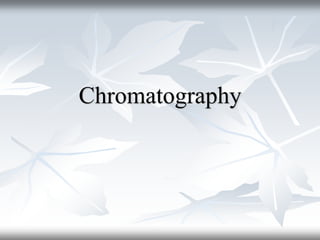
Chromatnogy.pptx
- 2. Chromatography Definition Chromatography is: a laboratory technique used to separate mixtures of compounds into their individual components based on their ability to move through different media when exposed to certain solvents.
- 3. Introduction ( Chromatography ) Chromatography is an incredibly valuable tool for research and development of chemicals, pharmaceuticals and many other industries. Chromatography is a form of physical separation technique used to separate mixtures of compounds into their individual components. It works by taking advantage of differences in the rates at which molecules move through different media when a force is applied. Chromatography has found applications in many fields, including industrial, environmental and biomedical analyses
- 4. Principles 1. Separation is achieved by the differential interactions of a sample mixture with the stationary phase and mobile phase in chromatography. 2. The ability of a given compound to partition between different phases is determined by its affinity to each phase, which can be affected by the polarity, size, shape and solubility of the compound. 3.In liquid chromatography, retention time is an important factor that affects separations. It is determined by the amount of sample adsorbed to the surface of the stationary phase compared to that of the mobile phase, or “residence time” in the column. 4. Different detectors are used for different applications. Mass spectrometer (MS) detectors are commonly used for qualitative analysis and identification purposes, while other detectors such as ultraviolet-visible (UV-Vis) absorbance detector and refractive index (RI) detector are used for quantification purpose in HPLC techniques.
- 5. History The method was first named "chromatography" in 1906 by a German chemist, Richard Willstatter as he conducted experiments to identify the chemical compounds of Chlorophyll. In the early 1920s, van Deemter and his collaborators saw chromatography as an opportunity to use gas phase molecules as mobile phases, rather than liquids. In 1930, Archer J.P. Martin received a Nobel Prize for developing paper chromatography and partition chromatography.
- 6. Separations in TLC involve distributing a mixture of two or more substances between a stationary phase and a mobile phase. The stationary phase: is a thin layer of adsorbent (usually silica gel or alumina) coated on a plate. The mobile phase: is a developing liquid which travels up the stationary phase, carrying the samples with it. Components of the samples will separate on the stationary phase according to how much they adsorb on the stationary phase versus how much they dissolve in the mobile phase.
- 7. According to mobile phase: 1- Liquid chromatography: mobile phase is a liquid. (LLC, LSC). Classification of chromatography
- 8. According to mobile phase: 2- Gas chromatography : mobile phase is a gas. (GSC, GLC). Classification of chromatography
- 9. According to the packing of the stationary phase: Classification of chromatography 1- Thin layer chromatography (TLC): the stationary phase is a thin layer supported on glass, plastic or aluminum plates.
- 10. 1-Thin layer chromatography (TLC) is a method for identifying substances and testing the purity of compounds. TLC is a useful technique because it is relatively quick and requires small quantities of material.
- 11. According to the packing of the stationary phase: Classification of chromatography 2- Paper chromatography (PC): the stationary phase is a thin film of liquid supported on an inert support.
- 12. 2-Paper Chromatography A method of partition chromatography using filter paper strips as carrier or inert support. The factor governing separation of mixtures of solutes on filter paper is the partition between two immiscible phases. One is usually water adsorbed on cellulose fibres in the paper (stationary phase). The second is the organic solvent flows past the sample on the paper (stationary phase).
- 13. According to the packing of the stationary phase: Classification of chromatography 3- Column chromatography (CC): stationary phase is packed in a glass column.
- 14. 3-Column Chromatography Column chromatography Stationary phase is held in a narrow tube through which the mobile phase is forced under pressure or under the effect of gravity
- 15. According to the force of separation: Classification of chromatography 2-Affinity chromatography. 1-Adsorption chromatography. Ion exchange chromatography
- 16. According to the force of separation: Classification of chromatography 3-Partition chromatography. 4-Gel filtration chromatography.
- 17. According to the force of separation: Classification of chromatography 5-Ion exchange chromatography
- 18. Purpose and uses Is a technique used to separate and identify the components of a mixture. Works by allowing the molecules present in the mixture to distribute themselves between a stationary and a mobile medium. Molecules that spend most of their time in the mobile phase are carried along faster.
- 19. Conclusion In conclusion: • chromatography is a powerful and important tool in the field of analytical chemistry • It offers high resolution separation, can be used to purify compounds and it is relatively easy and cheap to use. • Its applications are found in many areas of research including medicine, food analysis, materials science and environmental studies, among others. • Chromatography is undoubtedly one of the most widely used techniques in chemical analysis.
- 21. References 1. Principles of chromatography | Stationary phase (article) | Khan Academy 2. https://www.khanacademy.org/science/class-11-chemistry- india/xfbb6cb8fc2bd00c8:in-in-organic-chemistry-some-basic-principles- and-techniques/xfbb6cb8fc2bd00c8:in-in-methods-of-purification-of- organic-compounds/v/simple-and-fractional-distillations 3. Chromatography | Definition, Types, & Facts | Britannica 4. What is Chromatography and How Does It Work? (thermofisher.com) 5. Chromatography - an overview | ScienceDirect Topics 6. Chromatography - Chemistry LibreTexts